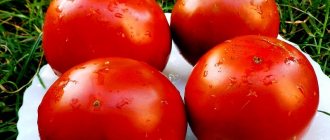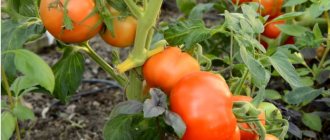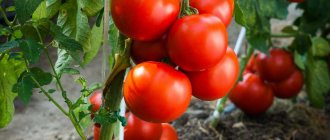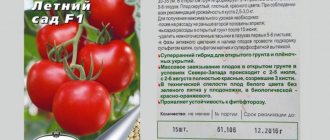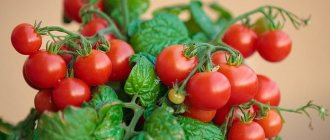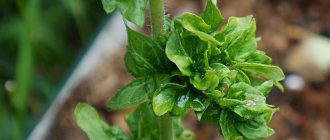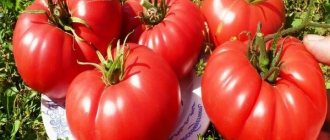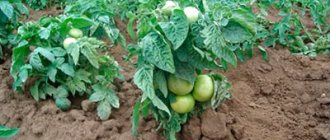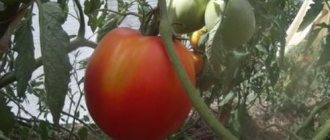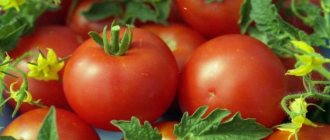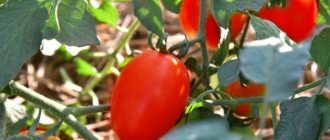Author's rating
Author of the article
Yakov Pavlovich
Professor, Head of the Department of Vegetable Growing
Articles written
153
In regions with a cold climate and mild summers, it is difficult to grow a high-quality and abundant harvest of heat-loving tomatoes. But thanks to the many years of work of Ural scientists, a new variety of vegetable crop was developed, characterized by resistance to sudden temperature changes.
The hybrid tomato variety Red Guard of the f1 generation was released in 2012 and immediately received positive reviews among professional vegetable growers.
Characteristics and description of culture
Red Guard tomatoes are characterized by very early ripening, high fruiting rates and excellent taste properties, for which they have received a premium class level among professionals.
- The bushes are compact, with a limited growth point, reaching a maximum height of 80 centimeters.
- The hybrid is not prone to growth, but it is recommended to trim off excess side shoots.
- The leaf blades are smooth, light green in color.
- During the growing season, racemose inflorescences form on the bushes, each of which bears from 5 to 9 fruits.
- Full ripening of vegetables occurs 2 months after the sprouts appear.
- The yield of the hybrid is high. Each plant produces up to 5 kilograms of selected tomatoes.
- By the time of ripening, the weight of each vegetable is from 200 to 250 grams, which threatens the plant with serious overload. To prevent the bushes from breaking off, additional supports are installed on the beds.
- Ripe fruits have a rounded contour, with slight ribbing at the top.
- The skin is dense, thin, and by the time it ripens it acquires a bright red hue.
- The pulp of the Red Guard is juicy, with a small amount of seeds, the taste is sweetish with an aroma characteristic of the culture.
- The hybrid easily tolerates sudden temperature changes and is unpretentious to lighting.
- Thanks to the work of scientists, tomatoes of the Red Guard variety have increased resistance to damage by fungi, viruses and harmful insects.
Expert opinion
Stanislav Pavlovich
Gardener with 17 years of experience and our expert
Ask a Question
Important! In temperate and northern latitudes, tomatoes of the Red Guard variety are recommended to be grown in greenhouses and greenhouses. In regions with a southern climate, the hybrid is planted in open ground.
Growing and care
Hybrid seeds do not need to be disinfected or activated, since they are completely ready for planting and have good germination.
Excellent predecessors are
- cucumbers
- turnip
- onion
- cabbage.
There are 4 plants per 1 m2.
Tomato needs moderate watering. In hot weather, the frequency is 3-4 times a week. The amount of water per bush varies between 2-4 liters. At the flowering stage, the volume of liquid is increased to 5 liters. When ripe, water 2 times a week to avoid cracking.
Advantages and disadvantages of tomato Red Guard F1
To get an abundant and high-quality harvest of fresh vegetables, before planting it is recommended to familiarize yourself with the possible advantages and disadvantages of the vegetable variety.
Advantages:
- Rapid formation and ripening of vegetables.
- Resistance to climatic and weather conditions.
- Excellent natural immunity to diseases and harmful insects.
- Easy to grow and care for.
- Possibility of universal use of vegetables.
Also, the advantages include a long shelf life and the possibility of long-distance transportation of ripened fruits.
Disadvantages include the bushes' tendency to overload and the need to install additional support structures.
Reference! Tomatoes of the Red Guard variety are not included in the state register of vegetable crops, which means that varietal testing has not been carried out. Therefore, the positive and negative characteristics of the plant are based on reviews from vegetable growers.
Description of fruits
- The fruits of the “Red Guard” are equal in size, round, with barely noticeable ribs near the stalk. The thick, glossy skin of tomatoes is colored scarlet. The inside of the fruit is also bright red, without hard whitish veins. The pulp with a low seed content is fleshy, sugary at the break, dense, but at the same time juicy.
- Unlike the insipid and watery hybrid Dutch tomatoes, the taste of the “Red Guard” fruits is bright, rich, sweet, typically “tomato-like”
- Weighing from 160 to 220 g, the tomatoes of this hybrid are collected in 7-9 pieces in compact, elegant clusters.
- Red Guard tomatoes are not prone to cracking and can withstand long-term transportation perfectly.
- Being picked slightly unripe, tomatoes of this hybrid variety can be stored for 3-4 weeks without losing their presentation.
- “Red Guard” bears fruit until frost; its last tomatoes, picked at the stage of milky ripeness, ripen together in a dark and warm room.
The taste of the fruits of this hybrid cannot be called particularly delicious, however, taking into account its fantastic disease resistance, absolute unpretentiousness and high yield, the “Red Guard” tomato can be safely recommended to all amateur gardeners living in the risky farming zone. Being practically problem-free, this hybrid can also serve well vegetable growers in the southern regions, where it makes sense to cultivate it as a kind of “safety net” option.
Subtleties of growing a plant
The hybrid form of tomatoes is grown from seeds using the seedling method. Planting material is purchased from nurseries or garden centers. Seeds collected independently from the previous harvest lose the main characteristics and properties of the hybrid crop.
See also: Soil for tomatoes - preparing nutritious soil with your own hands
How to grow seedlings
To get an early harvest of vegetables, seedlings are planted from late March to mid-April.
- Flower pots, plastic containers or glasses are suitable as containers for planting.
- You can buy fertile soil mixture at flower shops or make it yourself. To do this, garden soil is mixed with humus, sand and peat, and organic and mineral substances are added. The finished soil is treated with a manganese solution.
- Holes are punched at the bottom of the containers to drain excess moisture and filled with fertile soil.
- Holes or grooves are dug on the soil surface, no more than 1.5 centimeters deep.
- The distance between plantings is maintained within 1 centimeter.
- The seeds are placed in the prepared soil and sprinkled with earth on top, thoroughly moistened with a spray bottle.
- Containers with plantings are covered with plastic film and transferred to a warm, well-lit room.
- After the sprouts appear, the cover is removed.
- After 2-3 tomato leaves appear, the plants are planted in different containers with fertile soil.
Next, the hybrid form of tomatoes is watered, fed and loosened as necessary.
Transplantation to a permanent place
The timing of transferring seedlings to a permanent place of growth depends on the weather conditions of the region and the method of further growing the vegetable crop.
If tomatoes are supposed to be grown in greenhouse conditions, then the timing of transplanting the crop is not of great importance. The sooner the bushes find themselves in a permanent place of growth, the faster they will take root and begin active growth and development.
For open ground, planting dates are set for the end of May. In the southern regions, crop transplantation is carried out 2-3 weeks earlier.
- Beds for tomatoes are chosen on flat, well-lit areas with fertile, loose soil.
- The soil is dug up and loosened, organic matter and minerals are added.
- Holes are dug in the prepared beds, up to 30 centimeters deep.
- The distance between seedlings is maintained within 40 centimeters, between ridges up to 60-70 centimeters.
- Seedlings are transferred into the holes, sprinkled with earth on top and moistened abundantly.
- The planted bushes are tied to supporting structures.
Expert opinion
Stanislav Pavlovich
Gardener with 17 years of experience and our expert
Ask a Question
Important! Tomatoes of the Red Guard variety are characterized by resistance to sudden changes in weather and temperature changes; plants are not afraid of return frosts.
Rules for caring for tomatoes
The hybrid form of tomatoes is characterized by unpretentiousness in further care. Tomatoes of the Red Guard variety are undemanding in terms of watering schedules, lighting and fertilizing. But errors in agricultural technology increase the risk of reduced vegetable yields.
Weeding and loosening
Activities for loosening the beds are an integral procedure for caring for tomatoes. The work is carried out in conjunction with irrigation. In this case, the plant rhizomes are quickly enriched with oxygen and receive the nutrients necessary for growth.
See also: How to properly plant tomato seedlings without picking
Weed removal is carried out as necessary. Weeds deplete the soil, shade tomatoes from sunlight, and are carriers of fungal and viral infections and pests.
Stepsonning and formation
In greenhouse conditions, a tomato bush of this variety is formed into 2-3 stems. This method of growing crops allows you to increase plant productivity. For open ground, use the formation of a bush with 1 stem. During the growing season, stepsons appear on the plants, taking away strength and nutrients intended for the development of fruits. The emerging shoots are removed, as well as the lower leaf plates of the bushes.
Garter
In greenhouses, stretched ropes or fishing line are used to tie up plants. When growing tomatoes in open soil, support pegs or special structures are installed in the beds, to which the bushes are tied.
Expert opinion
Stanislav Pavlovich
Gardener with 17 years of experience and our expert
Ask a Question
Important! Up to 4-5 kilograms of vegetables ripen on a compact plant at the same time, so additional support for tomatoes of the Red Guard variety is necessary.
Top dressing
The growing season of the hybrid crop is short. Therefore, fertilizing is carried out no more than 2 times during the entire season, alternately using organic and mineral fertilizers.
Harvesting and application of the variety
Tomatoes of this variety are characterized by uniform ripening, which simplifies the harvesting of vegetables. After harvesting, the tomatoes are placed in spacious boxes or containers and stored in a cool place.
The purpose of ripened vegetables is universal. Tomatoes of this variety are consumed fresh, added to vegetable salads, first and second courses. Also, tomatoes are used for winter preparations, making tomato paste, sauces and juices.
Farmer reviews
- Lydia Viktorovna. Tver region. I am new to vegetable growing, so I try to purchase seeds of unpretentious vegetable crops. Last year, a nursery consultant recommended purchasing Red Guard tomato seeds. I had never grown tomatoes in my garden, so I very much doubted the positive result. I planted the seeds for seedlings in mid-April. I transplanted the seedlings into open ground at the end of May, and at the beginning of July I already harvested my first harvest of tomatoes.
- Lidia Stepanovna. Belgorod. An excellent variety, unpretentious in care, resistant to weather changes. The tomatoes ripened at the same time with excellent taste and aroma.
- Victor Nikolaevich. Krasnodar. I have been growing tomatoes of the Red Guard variety for 3 years. The variety is undemanding to lighting and fertilizing, practically not susceptible to diseases, but is sometimes affected by pests. From one bush I collect from 3 to 4 kilograms of ripe tomatoes of excellent quality and taste. Tomatoes are great for canning and vegetable dishes.
Previous
TomatoesSpecifics of growing tomatoes Doll F1 with reviews
Next
Tomatoes: Subtleties of cultivation, characteristics and description of tomato variety Fig Red
Photo
Below is a series of photographs of the described tomato variety.
In general, the “Red Guard” tomato is a high-yielding variety that differs from similar crops in its special aroma and taste. The variety does not require any special care and can grow in different regions of our country.
